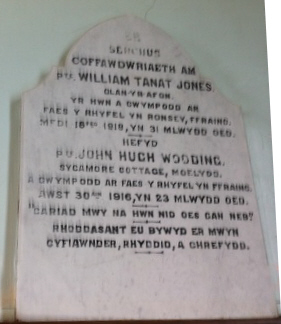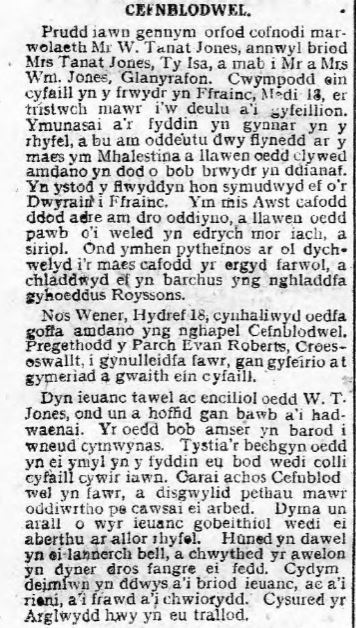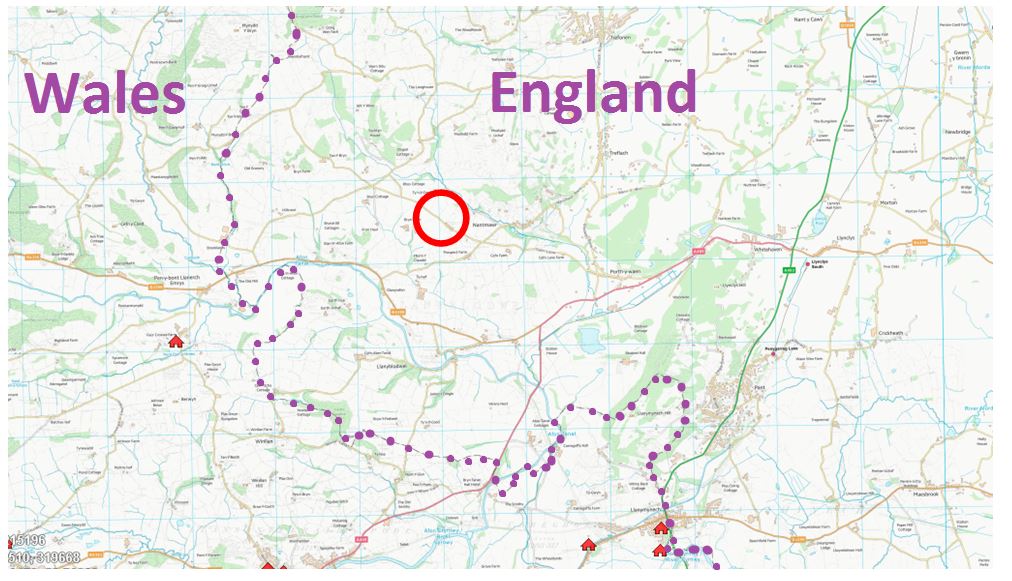A Welsh Memorial?
I recently received from the Revd Jennie Hurd a picture of a memorial in a Welsh chapel, which at the time of the First World War was a Wesleyan chapel known as Cefnblodwel.
 It is rather typical of the kind of memorial found in Welsh rural chapels: a marble slab with details of two members who died. The text translates as:
It is rather typical of the kind of memorial found in Welsh rural chapels: a marble slab with details of two members who died. The text translates as:
In loving memory of Pte William Tanat Jones, Glan-yr-Afon, who fell on the battlefield at Ronsey, France, 18th September 1918, aged 31
Also, Pte John Hugh Wooding, Sycamore Cottage, Moelydd, who fell on the battlefield in France, 30th August 1916, aged 23
“Greater love hath no man than this”
They gave their lives for Justice, Freedom and Religion
Although the biblical quotation (John 15:13) is one that is often seen in Welsh chapel memorials, the final line which explicitly places the men’s sacrifice as one for ‘Justice, Freedom and Religion’ is a stronger statement than is usually seen.
It is straightforward to find both men on the CWGC database. John Hugh Wooding is commemorated on the enormous memorial at Thiepval in the Somme region of France: he died while serving with the King’s Shropshire Light Infantry.
William Tanat Jones is actually buried in Ronssoy Communal Cemetery in the Somme region: he was serving with the 25th Battalion of the Royal Welsh Fusiliers.
Some information on William can be found in Welsh newspapers. The Llangollen Advertiser of 11 October 1918 notes how his death was announced in Llanyblodwel church:
On Sunday morning the Vicar (the Rev. J. Allen Jones) referred in feeling terms to the death in action on the west front of Pte. William Tanat Jones, Tyissa, who a month ago was at home on leave, and to the death of Arthur Lewis, The Stores, Porthywaen, who was killed in action in the recent Bulgarian fighting. The whole parish will lament their loss. The organist (Mr T. B. Griffiths) played the Dead March in “Saul.”
There are two items about him in Y Gwyliedydd Newydd (the Welsh Wesleyans’ weekly newspaper). The first is a report of his marriage, at Cefnblodwel chapel on 4 January 1916, to Miss Helena Jones, daughter of Mr and Mrs Jones of Ty Isa. William was noted as serving with the Montgomery Yeomanry (a unit which would be re-organised as the 25th Btn of the RWF in 1917).
Then there is a much more detailed report of his death in the issue of 6 November 1918.
We are very sad at having to record the death of Mr Tanat Jones, dear husband of Mrs Tanat Jones, Ty Isa, and son of Mr & Mrs Wm. Jones Glanyrafon. Our friend fell in the battle in France, 18 September, to the great sorrow of his family and friends. He joined the army early in the War, and for two years served on the field in Palestine and we were glad to hear that he came out of every battle uninjured. During this year he was transferred from the East to France. In August he was allowed home for a visit, and everyone was delighted to see him looking so well and cheerful. But within a fortnight of his return to the field of battle, he received a fatal blow and his body was respectfully buried in the public cemetery of Royssons.
On Friday evening, 18 October, a memorial service for him was held in Cefnblodwel chapel. The Rev. Evan Roberts, Oswestry, preached to a large congregation referring to the character and work of our friend.
W.T. Jones was a quiet, unassuming young man who was liked by all who knew him. He was always ready to do a favour. The young men who were around him in the army testify that they have lost a true friend. He had a great love for the cause in Cefnblodwel, and great things were expected of him had he been spared. Here is another hopeful young man sacrificed on the altar of war. May he rest tranquilly in the far-off field and may the breeze blow gently over the site of his grave. We sympathise deeply with his young bride and his parents, brother and sisters. May the Lord console them in their sorrow.
However, when trying to locate Cefnblodwel chapel on the database of Welsh chapels created by the Royal Commission on the Ancient and Historical Monuments of Wales, there was a problem: no such chapel was listed. Further investigation showed why: this chapel is well on the English side of the border, six miles south-west of Oswestry.
Searching on the web for more information about the two men, some interesting material comes to light. William Tanat Jones is commemorated on the gravestone of his parents (William and Ann Jones) in Nantmawr – the gravestone is in Welsh although Nantmawr is firmly in Shropshire.
Also in Nantmawr, there is a Roll of Honour of all the former pupils of the Nantmawr British School who served in the war, including the name of John Hugh Wooding. Further information about him can be found here.
It does not appear that either of these men is included in the ‘Welsh Book of Remembrance’, commissioned in 1928 (although one would have expected that William Tanat Jones should have been included as he served in a Welsh Regiment).
The services in the chapel at Cefnblodwel are now held in English, yet they still belong to the Welsh branch of the Methodist church. It all goes to show that the border areas can have interesting ideas about identity, and have no trouble with identifying with both ‘English’ and ‘Welsh’.
g.h.matthews April 27th, 2018
Posted In: Uncategorized

